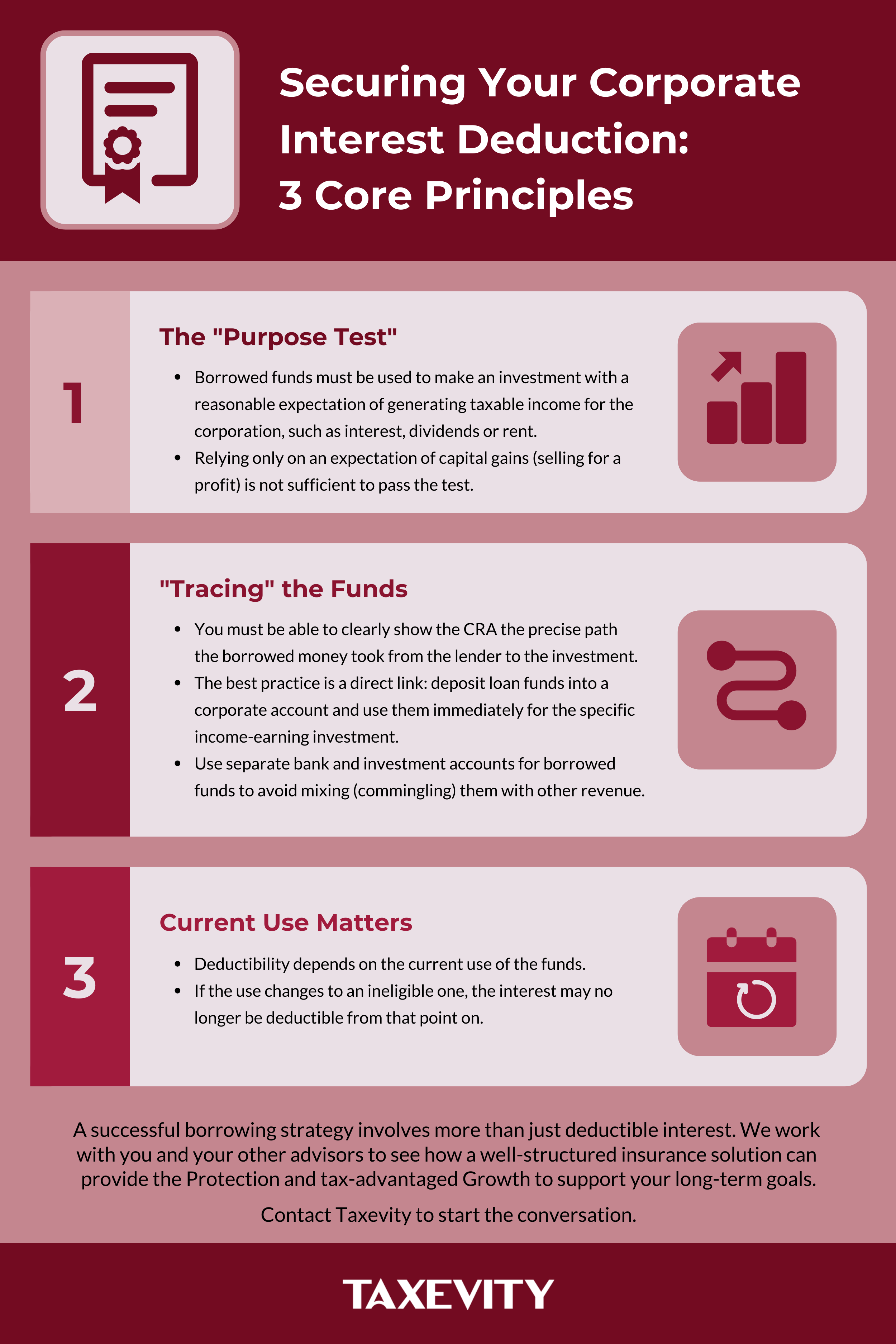Key Question for Business Owners
You understand using leverage to grow your business, but how can you use a corporate loan to build an investment portfolio and ensure the interest is tax-deductible?
- The “Purpose Test”: For the loan interest to be deductible, the borrowed money must be used to buy investments that are expected to produce taxable income, like dividends or interest. An expectation of only selling for a profit (capital gain) is not enough.
- A Clear Audit Trail: You must be able to prove to the CRA exactly where the borrowed money went. The best practice is to deposit the loan into a separate corporate account and use it immediately for the investment, creating a clean paper trail.
- Leverage Amplifies Outcomes: Using borrowed money can magnify your investment returns, but it also magnifies the risk if the investments perform poorly. Success requires a clear strategy and a team of advisors to manage this risk.
As a Canadian Business Owner or Incorporated Professional, you understand the power of strategic financial planning. If your corporation is considering or already using borrowed funds—whether to expand operations or to build an investment portfolio—understanding the tax deductibility of the loan interest is crucial. This Companion is designed to help you navigate the key Canadian income tax rules that determine when interest paid by your corporation can be deducted, ultimately reducing its taxable income.
This guide focuses on the principles of interest deductibility for corporations, particularly Canadian-Controlled Private Corporations (CCPCs) as of mid-2025. We will explore how you can strategically structure borrowing and investments to meet Canada Revenue Agency (CRA) requirements. While the Canadian tax landscape is complex, and you should always consult your accountant for advice tailored to your specific situation, understanding these key aspects allows you to make more informed decisions.
Our goal is to help you see how deductible interest can enhance your corporation’s financial protection and growth, and potentially expand its capacity for philanthropic impact.
Page Contents
Corporate Borrowing: For Business Operations vs. External Investments
When your corporation borrows money, the primary use of those funds dictates how the interest paid on the loan is treated for tax purposes.
- Investing Back in the Business: If your corporation borrows to invest directly in its active business operations—such as purchasing new equipment, expanding facilities, funding research and development, or increasing working capital—the interest on that loan is generally deductible. This is because these activities are undertaken for the purpose of earning business income.
- Investing in a Portfolio (Leveraged Investing): If your corporation borrows to acquire an external investment portfolio (e.g., stocks, bonds, mutual funds), this is often referred to as leveraged investing. The goal here is to accelerate the growth of your corporate investment portfolio beyond what might be achievable by using only the corporation’s existing capital. The interest on these types of loans can also be deductible, provided specific conditions, which we’ll explore, are met.
A. The Power and Pitfalls of Leverage
When your corporation borrows to invest in a portfolio, it controls a larger investment base. If these investments perform well, the returns are calculated on the total value (your corporation’s capital plus the borrowed funds), potentially amplifying gains.
However, leverage also magnifies risk. If investments perform poorly, losses are similarly amplified. Your corporation remains obligated to repay the loan and all accrued interest, regardless of investment performance. This means the corporation could lose more than its initial capital contribution to the investment pool, impacting its financial protection. Understanding this balance of opportunity and risk is key.
B. The Basic Structure of a Corporate Investment Loan (for Portfolios)
Typically, your corporation applies for a loan from a financial institution. The loan agreement specifies the principal, interest rate (fixed or variable), and repayment terms. The corporation then uses these borrowed funds, often combined with existing corporate capital, to purchase an investment portfolio, usually held within the corporation.
Interest Deductibility for Corporations: The Core Principles
For the interest your corporation pays on a loan to be tax-deductible, the borrowed money must be used for the purpose of earning income from a business or property (which includes investments). This is the “purpose test” under paragraph 20(1)(c) of the Income Tax Act.

A. The “Purpose Test”: Earning Taxable Income is Key
- Reasonable Expectation of Income: Your corporation must demonstrate that, at the time an investment is made with borrowed funds, there’s a reasonable expectation that this investment will generate taxable income (e.g., dividends from shares, interest from bonds, or rental income from property).
- Capital Gains Don’t Count (for this specific test): An expectation of only earning capital gains (i.e., selling the investment for more than its cost) is generally not sufficient to meet the purpose test for interest deductibility. The investment must have the potential to produce an ongoing, taxable income stream.
- Sufficiency of Income: The actual amount of taxable income earned doesn’t need to be a speficied amount. There just needs to be a reasonable expectation of some being earned.
- CRA’s View on Common Shares: For investments in common shares that may not pay immediate or regular dividends, the CRA generally permits interest deduction if the investee corporation’s dividend policy is unstated or indicates dividends will be paid “when operational circumstances permit.” If a corporation explicitly states it will not pay dividends, interest on funds borrowed to acquire its shares may not be deductible.
B. Tracing the Use of Borrowed Funds
It’s crucial to be able to demonstrate to the CRA exactly how the borrowed money was used. This is “tracing”.
- Direct Link: The clearest way is to show a direct link from the borrowed funds to the specific income-earning use (e.g., loan funds deposited and then immediately used to buy dividend-paying stocks).
- Separate Accounts: Using a separate bank account and investment account for borrowed funds and the investments acquired with them is highly recommended. This avoids mixing (commingling) funds, which complicates tracing.
- Current Use Matters: Interest deductibility is determined by the current use of the borrowed money. If the use changes from an eligible income-earning purpose to an ineligible one, the interest may cease to be deductible from that point forward.
C. Other Key Conditions
- Legal Obligation: The corporation must have a legal obligation to pay the interest.
- Reasonableness: The amount of interest must be reasonable, generally reflecting market rates.
Key Considerations for Corporate Investment Loans
A. Corporate-Owned Life Insurance (COLI) as Collateral
A primary strategy for using corporate-owned life insurance as collateral is the Immediate Financing Arrangement (IFA). Key points:
- The loan itself must still be for an income-earning purpose (e.g., an external investment portfolio or reinvestment in the active business). The COLI as collateral doesn’t automatically make the loan interest deductible.
- Interest on a loan taken specifically to pay COLI premiums is generally not deductible under the main interest deductibility rule.
- There’s a separate, complex rule (ITA 20(1)(e.2)) that may allow a limited deduction for a portion of the COLI premiums (specifically, the Net Cost of Pure Insurance) if the policy is assigned as collateral for an already deductible loan.
- Loans from Corporation to Shareholder for Personal Use: If your corporation borrows and then lends funds to you for personal use, the corporation’s interest on its loan is generally not deductible.
- Personal Guarantees: Personally guaranteeing a corporate loan exposes you to personal financial risk if the corporation defaults.
C. Holding Companies
A holding company (Holdco) can own investments, often funded by dividends from your operating company (Opco). If the Holdco borrows for further investment, the same interest deductibility rules apply. This structure can offer asset protection.
D. Excessive Interest and Financing Expenses Limitation (EIFEL)
Business owners should be aware of the EIFEL rules, which could limit the amount of net interest and financing expenses a corporation can deduct. However, for many typical CCPCs, these rules may not apply due to exemptions:
- Small CCPC Exclusion: Generally, if your CCPC (and associated corporations) had taxable capital employed in Canada of less than $50 million in the previous year.
- Low Net Interest Expense Exclusion: If your corporation (and its Canadian group entities) has aggregate net interest and financing expenses of $1 million or less in a taxation year.
If your corporation is larger or has complex financing, consult your accountant about EIFEL.
E. Record-Keeping: The Foundation
Meticulous records are essential to support interest deductibility: loan agreements, bank statements showing fund flows, investment statements, corporate resolutions, and records of income earned.
The Role of Your Professional Advisory Team
Successfully navigating corporate leveraged investing requires a team:
- Your Accountant (CPA): Essential for tax advice on interest deductibility, AAII, EIFEL, compliance, and filings. For a detailed perspective to share with your accountant, please see our Accountant Companion: Navigating Canadian Interest Deductibility for Investment Loans.
- Your Wealth Advisor: Helps assess risk, select appropriate income-earning investments, and align the strategy with overall financial plans. For more on general principles of interest deductibility relevant to discussions with your wealth advisor, see our Wealth Advisor Companion: Charting Interest Deductibility for Leveraged Investing.
- Your Insurance Professional (Taxevity): As the architects of the insurance foundation, our expertise is vital when using COLI for strategies like an Immediate Financing Arrangement (IFA), for advanced risk management, or for sophisticated estate planning.
- Your Lender: For understanding loan terms and requirements.
- Legal Counsel: For reviewing agreements and corporate structuring.
Strategic Borrowing for Corporate Success
Using your corporation to borrow for investment can be a smart strategy to accelerate wealth growth. The ability to deduct loan interest is a key component, reducing the borrowing cost.
However, success hinges on meeting the “purpose of earning income” test, meticulous tracing, and understanding the risks. This Companion provides provides a general overview. Your corporation’s specific circumstances will dictate the optimal approach. At Taxevity, we work closely with your other independent advisors to implement a plan aligned with your objectives for financial protection, sustained growth, and meaningful impact. To get started, arrange a private chat.





